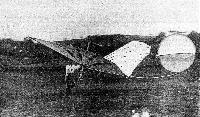
Описание
Страна: Великобритания
Год: 1895
Планер
Варианты
- Pilcher - Bat / Beetle / Gull - 1895 - Великобритания
- Pilcher - Hawk - 1897 - Великобритания
- P.Lewis British Aircraft 1809-1914 (Putnam)
- M.Goodall, A.Tagg British Aircraft before the Great War (Schiffer)
-
M.Goodall, A.Tagg - British Aircraft before the Great War /Schiffer/
Pilcher Bat glider. The first version of 1895 built and tested near Glasgow.
-
M.Goodall, A.Tagg - British Aircraft before the Great War /Schiffer/
Pilcher Bat. The second version was fitted with a tailplane.
-
P.Jarrett - Pioneer Aircraft: Early Aviation Before 1914 /Putnam/
Percy Pilcher made no aerodynamic experiments, but he quickly found that the acute dihedral he had given the wings of his 1895 Bat glider, as seen here, greatly inhibited his weight-shift control and made the machine very vulnerable to side gusts, especially on the ground. After reducing the angle until it was 'almost neutral' he was able to make successful flight.
-
P.Lewis - British Aircraft 1809-1914 /Putnam/
Pilcher Bat
-
P.Lewis - British Aircraft 1809-1914 /Putnam/
Pilcher Beetle
-
M.Goodall, A.Tagg - British Aircraft before the Great War /Schiffer/
The Beetle. Pilcher's second glider was unsatisfactory and was soon abandoned in 1895.
-
M.Goodall, A.Tagg - British Aircraft before the Great War /Schiffer/
Pilcher constructed the Gull, his third glider, in Scotland but moved to Eynsford in Kent in 1896 where it flew successfully.
P.Lewis British Aircraft 1809-1914 (Putnam)
Pilcher Bat
Percy S. Pilcher was born in 1866 and, after serving in the Royal Navy, turned to civil engineering and became a lecturer at Glasgow University. His first glider, the Bat, was a monoplane and was constructed early in 1895. Before making any flights with it, Pilcher went to Berlin to watch Otto Lilienthal, and then made his first glides with the Bat at Cardross on the banks of the River Clyde during June, 1895. Pronounced dihedral was a feature of the wings and the machine was without a horizontal tail although a fin was fitted. After the first tests, Pilcher decided to follow Lilienthal's advice and added a tailplane, thereafter making many successful flights with the Bat. Wing area, 150 sq. ft. Weight empty, 45 lb. Weight loaded. 190 lb.
Pilcher Beetle
The Beetle was the second monoplane glider designed by Pilcher and was built during 1895. Wing area, 170 sq. ft. Weight empty, 80 lb. Weight loaded, 225"lb.
Pilcher Gull
Pilcher's third glider was constructed during 1896 and was named the Gull. Considerably larger monoplane wings of 300 sq. ft. area were fitted, compared with those of his first and second gliders, and were found to have too much lift. Weight empty. 55 lb.
Описание:








